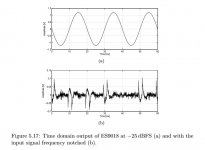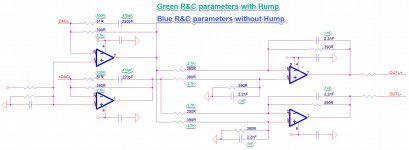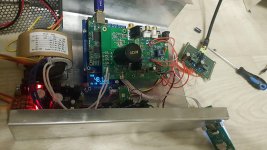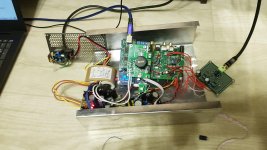One would wonder how AKM is still in business, do you have any idea of the cost of such a cycle? Or how would the chip designers and/or the layout team integrate the subjective results in a new design version?
Syn, since you are an expert on ASIC fabrication, for the benefit of those
here that are not (including me), could you take us through the costing and
development process of a typical high performance DAC?
I've personally received emails from DAC manufacturers claiming subjective outcome being part of the development process.
It would be nice to be able to put this into some kind of perspective with some real numbers.
Thanks,
TCD
Sure, I would appreciate any ideas (even theoretical) on how a Golden Ear could impact a chip design. Meantime, obviously, you know that the AKM chips are designed with the help of a Golden Ears, isn't it?
He is called the audio Meister and it is all on the AKM website under Velvet Sound.
>es9038q2m dac on two circuits and modify it, thinking that two circuits are better. thank you for the post where you explained that this is a marketing ploy.
I don’t think it’s a marketing ploy. Mu humble theory is below.
Sabre made significant step in DACs improvement, but got a drawback – high C2/C3 harmonics they had to deal with. So invented a compensation strategy with registers 22-25 to set C2/C3 in the reverse phase to make the output clean. Obviously the register values are unique to DAC instance, otherwise it will be hidden from the users availability.
The curious thing is the default C2/C3 values are not zero. The C2/C3 presence was promoted though as a way to compensate the following “cascades”. But looks like it’s for the DAC itself.
Method to inject the harmonics is not perfect, so DAC injects C2/C3 equally into DAC+ and DAC- (symmetrical) outputs (DAC+/- pins don’t come from separate “ladders” obviously) . So the following symmetrical (balanced) stage easily eliminate C2 but doubles C3 (that is exactly what I saw during my experiments). C3 can’t be compensated completely at all as the level of C3 presented in the symmetrical DAC+/DAC- outputs is equal (in the reverse phases), so the next balanced (subtracting) stage just doubles the C3 level
The method to move forward is using 2 DACs and get DAC- and DAC+ for balancing from different DACs to make the C2/C3 approach really universal and exhaustive.
Well now you are puzzling me. on the one hand, reducing the bandwidth in the register should fix everything on the 1-chip implementation. according to Mark. on the other hand you dispute this and argue that only the 2-chip implementation can be fixed. I only found this method on the Internet to eliminate the ess hump. converting food into topping d50s is not difficult. I have all the food "on hand", it won't take long to solder it. the question is how to place it there) but is it worth the investment in the purchase of this device to eliminate the hump?
have repeatedly raised this issue in this forum about the hump. but no concrete decision was made regarding the "ess hump" on this Chinese board. the chip itself surprised me with its playback capabilities. but after doing a certain job, spending money and time, I don't want to know that there is one "but" that I cannot fix. decision? buy ess9038pro and modify, buy topping d50s, which already have iv and modify? buy ak4497 since ak4499 is still "raw"? or is there still a solution to remove the "hump" in es9038q2m?)))
...reducing the bandwidth in the register should fix everything on the 1-chip implementation. according to Mark...
Not 'fix everything' exactly. It is the easiest way to get the most audible improvement by programming registers. Setting registers for full synchronous operation has benefits too, but that mode requires a lot of hardware changes including having two clocks instead of one.
Regarding the 'hump,' Scott Wurcer was privy to some information from ESS regarding the issue. They wanted to know if the opamp could be the cause. Please see the image Scott provided and that I have attached below.
Two different detailed hump correction schemes were posted on ASR. In addition, John Siau of Benchmark Media commented on the problem:
Review and Measurements of Benchmark DAC3 | Page 16 | Audio Science Review (ASR) Forum
One of the detailed methods was described as:
ESS THD ‘Hump’ Investigation | Page 14 | Audio Science Review (ASR) Forum
The other one is at:
How to Fix ESS Hump on SGD1 and LA-QXD1 | Audio Science Review (ASR) Forum
Also, the 'hump' is potentially an issue with all ESS dacs. Regarding the various links above, the last one seems to be one Scott Wurcer felt was the right approach.
EDIT: Regarding harmonic correction registers, if the output stage is well designed and implemented, the registers should not be needed. John Westlake, a well known and prolific professional dac designer says that use of the correction registers always hurts the sound and its better to leave them disabled even if there is a small amount of remaining 2nd or 3rd order HD.
Attachments
Last edited:
Syn, since you are an expert on ASIC fabrication, for the benefit of those
here that are not (including me), could you take us through the costing and
development process of a typical high performance DAC?
A typical iteration for a new ASIC would cost anywhere between 2 to 3 M$. This includes a mask set (1-2M$), batch processing, wafer testing, assembly, final testing, and of course the cost of the Golden Ear called to evaluate the results. His feedback cold be used to either modify the design/layout (requiring a new mask set) or to tune the manufacturing process.
The question that you and others are avoiding as a hot potato is how would this feedback be used? How would a feedback of "not enough sound stage depth" translate into design or process change/tuning? Instead, you prefer to believe the marketing materials and advertising, so be it...
Tongue in cheek: it would make sense to use a Golden Ear to evaluate products intended for mass production, like memory chips. A high end audio DAC is a niche (or boutique) design that will inherently sell in minuscule quantities, so chances to recoup the investment and perhaps design iteration costs are low. That's one reason why the big guys (TI, AD) just gave up the race for audio grade DACs and ADCs, there's a bigger fish to fry than making the Terry's and Mark4's of the world happy.
What constitutes high performance DAC?could you take us through the costing and
development process of a typical high performance DAC?
... I have a high level audiophile friend. tube amplifiers that he soldered, silver wires, vinyl and handmade speakers that he is ready to put up in Hong Kong for an exhibition. and he criticized Mark's output on op-amps and recommended transformers and tubes. recently listening modified es9038q2m Was surprised. and said that it sounds very good. since my dac is already controlled with a remote control, I am not chasing these cheap Chinese crafts. the question was how to remove this "hump". Mark, why don't we use this Skott Wurser scheme? but only the one in post 3003?
Scott Wurcer involvement was only to help ESS find out about any problems with their dacs.
The version in post #3003 is derivative of an earlier Scott Wurcer design that has a Gaussian filter characteristic to help preserve waveshape (preserve relative phase between different frequencies). That is important for good sound quality, at least I think so. Besides, I just said it was an output stage to try. I tried it myself and thought it could sound quite good.
Regarding the hump issue, the first fix posted at ASR really was just something that changed the offset voltage for the noninverting I/V opamps inputs. Normally, that is set to AVCC/2 volts. However, it could be set to something lower, say if someone wanted to get rid if the I/V output offset using the I/V opamps to do it. It will cause asymmetrical current draw from the dac outputs in that case. IMO, it also hurts the sound a little. Anyway, all the calculations are not necessary. One can just connect a pot as a voltage divider to AVCC and dial in an offset voltage for the I/V opamps as desired. Once a suitable division ratio is found, the pot should be replaced with good quality metal film or thin film fixed resistors (since pots are not as linear - something Bruno Putzys and others have have pointed out).
The second fix at ASR involved tweaking the resistors and caps in the output stage to minimize the hump. Well, there goes the Gaussian filter...
Anyway, some people found out the first fix didn't work for them, and others suggested that the second fix might depend in part on layout, opamp selection, etc., so one should probably check by adjusting all the R's and C's in the output stage as necessary to make sure the hump is minimized for their particular build. It means someone has to be setup to measure the hump, which not everybody is.
Since my dac sounded good to me and to my high end designer friend, I thought the version in post #3003 an acceptable choice.
The version in post #3003 is derivative of an earlier Scott Wurcer design that has a Gaussian filter characteristic to help preserve waveshape (preserve relative phase between different frequencies). That is important for good sound quality, at least I think so. Besides, I just said it was an output stage to try. I tried it myself and thought it could sound quite good.
Regarding the hump issue, the first fix posted at ASR really was just something that changed the offset voltage for the noninverting I/V opamps inputs. Normally, that is set to AVCC/2 volts. However, it could be set to something lower, say if someone wanted to get rid if the I/V output offset using the I/V opamps to do it. It will cause asymmetrical current draw from the dac outputs in that case. IMO, it also hurts the sound a little. Anyway, all the calculations are not necessary. One can just connect a pot as a voltage divider to AVCC and dial in an offset voltage for the I/V opamps as desired. Once a suitable division ratio is found, the pot should be replaced with good quality metal film or thin film fixed resistors (since pots are not as linear - something Bruno Putzys and others have have pointed out).
The second fix at ASR involved tweaking the resistors and caps in the output stage to minimize the hump. Well, there goes the Gaussian filter...
Anyway, some people found out the first fix didn't work for them, and others suggested that the second fix might depend in part on layout, opamp selection, etc., so one should probably check by adjusting all the R's and C's in the output stage as necessary to make sure the hump is minimized for their particular build. It means someone has to be setup to measure the hump, which not everybody is.
Since my dac sounded good to me and to my high end designer friend, I thought the version in post #3003 an acceptable choice.
Last edited:
have repeatedly raised this issue in this forum about the hump. but no concrete decision was made regarding the "ess hump" on this Chinese board. the chip itself surprised me with its playback capabilities. but after doing a certain job, spending money and time, I don't want to know that there is one "but" that I cannot fix. decision? buy ess9038pro and modify, buy topping d50s, which already have iv and modify? buy ak4497 since ak4499 is still "raw"? or is there still a solution to remove the "hump" in es9038q2m?)))
>2-chip implementation can be fixed
There could be several meanings of a fix, Anyway a DAC can’t be ideal.
I just have a logic that 2 ES9038Q2Ms (and maybe other) DACs simplifies the THD elimination significantly.
>converting food into topping d50s is not difficult.
The good sample of the 2 DACs result, I have such
>but is it worth the investment in the purchase of this device to eliminate the hump?
Up to you ;-)
>but no concrete decision was made regarding the "ess hump" on this Chinese board
I haven't given up the trying so far, so stay tuned
>buy topping d50s, which already have iv and modify?
For me there is nothing to modify in D50. It’s good enough “as is”
not ready to argue without listening to d50. but d50 with a hump. d50s without hump. the Chinese themselves write about it. also it is the pure "analog" power supply of avcc that is definitely better than the "digital" one. convinced myself using in avcc first tps7a4700, and now lt3042. also there is no guarantee that smd elements in d50 are of high quality. also my case is made of aluminum, I have not finished it yet. I had a reason to buy d50s only because of the "hump".>2-chip implementation can be fixed
There could be several meanings of a fix, Anyway a DAC can’t be ideal.
I just have a logic that 2 ES9038Q2Ms (and maybe other) DACs simplifies the THD elimination significantly.
>converting food into topping d50s is not difficult.
The good sample of the 2 DACs result, I have such
>but is it worth the investment in the purchase of this device to eliminate the hump?
Up to you ;-)
>but no concrete decision was made regarding the "ess hump" on this Chinese board
I haven't given up the trying so far, so stay tuned
>buy topping d50s, which already have iv and modify?
For me there is nothing to modify in D50. It’s good enough “as is”
Guys if you Google topping d50S test you can see from measurents should be fine now?
judging by the graphs, yes. but if the Chinese sell dartzeel made of ****, for decent money, where the body, according to reviews, is made of low-quality aluminum, then it's not a fact that the d50 is made of quality) where have you seen high-quality golimy china ??? I saw only rubber tires for the car and then a good copy of the Japanese. I live on the border with them and even eat their hideous vegetables. Mark is right - they do everything as cheaply and sell as possible.
Scott Wurcer involvement was only to help ESS find out about any problems with their dacs.
The version in post #3003 is derivative of an earlier Scott Wurcer design that has a Gaussian filter characteristic to help preserve waveshape (preserve relative phase between different frequencies). That is important for good sound quality, at least I think so. Besides, I just said it was an output stage to try. I tried it myself and thought it could sound quite good.
Regarding the hump issue, the first fix posted at ASR really was just something that changed the offset voltage for the noninverting I/V opamps inputs. Normally, that is set to AVCC/2 volts. However, it could be set to something lower, say if someone wanted to get rid if the I/V output offset using the I/V opamps to do it. It will cause asymmetrical current draw from the dac outputs in that case. IMO, it also hurts the sound a little. Anyway, all the calculations are not necessary. One can just connect a pot as a voltage divider to AVCC and dial in an offset voltage for the I/V opamps as desired. Once a suitable division ratio is found, the pot should be replaced with good quality metal film or thin film fixed resistors (since pots are not as linear - something Bruno Putzys and others have have pointed out).
The second fix at ASR involved tweaking the resistors and caps in the output stage to minimize the hump. Well, there goes the Gaussian filter...
Anyway, some people found out the first fix didn't work for them, and others suggested that the second fix might depend in part on layout, opamp selection, etc., so one should probably check by adjusting all the R's and C's in the output stage as necessary to make sure the hump is minimized for their particular build. It means someone has to be setup to measure the hump, which not everybody is.
Since my dac sounded good to me and to my high end designer friend, I thought the version in post #3003 an acceptable choice.
Mark, can I try the schematic iv I attached? what do you think? using op1612. and do not pay attention to the attacks of people. what they are trying to prove is not clear to anyone. only they understand) it seems that they are very offended by life) you do not have a commercial project. you share your experience. who doesn't like what - let them walk in the forest)) if you create a separate branch about ak4499 let me know. I read the whole thread about es9038q2m. I will also read about ak4499 with pleasure.
syn08, Mark makes himself happywith his hands and head)
I think you missed what triggered this exchange; you may want to read a few pages back. Or not.
Otherwise, I'm sure he does. I can only hope that his happiness is your happiness too.
- Home
- Source & Line
- Digital Line Level
- ES9038Q2M Board



